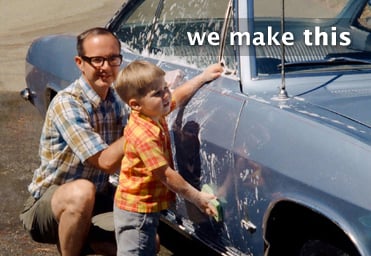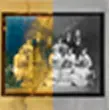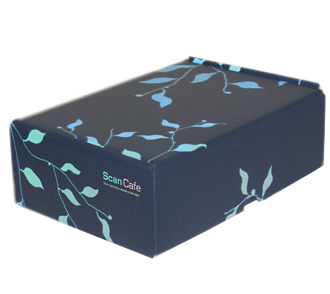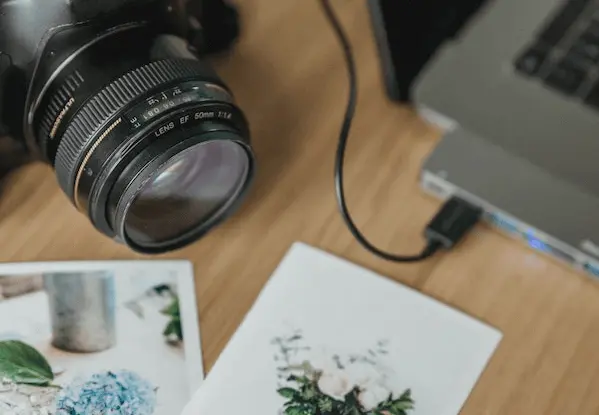How movie film decays
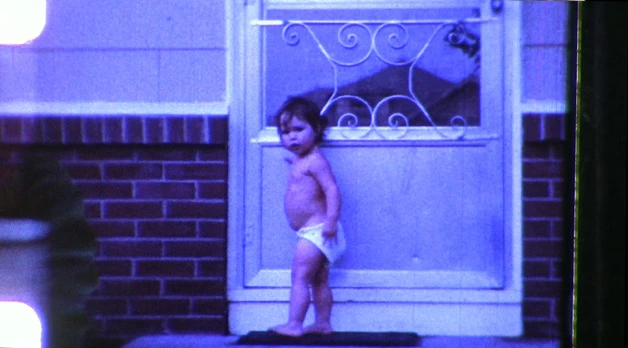
This "raw" frame was scanned from Super 8mm film that is 50 years old. Note the blue color shift, probably due to the onset of vinegar syndrome, rather than to a classic deterioration of an organic dye. Movie: W Lagrone, 1961
Movie film, when you look at it up close, looks a lot like photographic negatives.1 The most important of those similarities is that color movie film is produced as part of a chromogenic process, with the same kind of color shift problems that are found in photographic color negatives over time. But it turns out that movie film also has many unique longevity problems. The long and short of it? Get your film scanned now.
Fading & color shift in movie film
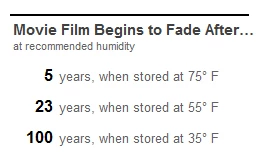
source: Wilhelm & Brower, 1993 (p. 318). Typical 1960s Super 8 color print film. Time shown is for least stable image dye to lose 10% density.
Hollywood has long worried about the problem of fading and color shift in motion pictures. The director Stephen Spielberg once complained in 1979 that "after only five years the blue is leaving the waters of Jaws while the blood spurting from Robert Shaw's mouth gets redder and redder..." Director Martin Scorsese led an industry push in the 1980s that focused on making Hollywood's standard 35mm movie film more stable, and was largely successful. But the 50 years of consumer memories that were recorded on 8mm, Super 8mm, and 16mm film are very much at risk, and the period between 1950 and 1981 was marked by particularly poor color stability for most movie films. 2
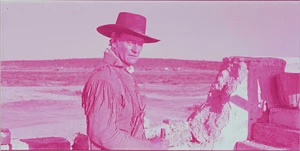
This 2009 frame from the The Alamo (1960) exhibits classic color shift. Source: film preservationist Robert Harris.
Typically speaking, the cyan, magenta, and yellow dyes that are used to record the color in color home movie film decay at different rates, causing an overall shift toward one color. Depending on the specific film, this could result in image that is reddish (as above) or any of a number of other colors. Some color shift can be attributed not to dye decay directly, but the interaction of some of the components in the film with the acetic acid produced by vinegar syndrome.
Vinegar syndrome
Common consumer home movie films since the 1950s are most commonly printed on a "safety" acetate base layer3. The trouble with acetate base is that it can degrade substantially, and in a process that is mostly independent of the color decay discussed above.
Due to moisture, or temperature, over time the acetate base can decompose, giving off, as a side product, free acetic acid, which is released first inside the film base then diffuses to the surface. Literally, the film will begin to smell like vinegar. Worse yet, once the free acetic acid reaches a certain absolute point, the reaction becomes "autocatalytic", feeding on itself and causing an exponential jump in the creation of more acetic acid.
Vinegar syndrome is a potentially devastating problem with old home movies, because in advanced stages it will make the film brittle and warped, as the base itself will shrink faster than the rest of the film. Even a 1% shrinkage might be enough to prevent saving your film except by extremely expensive and risky methods.
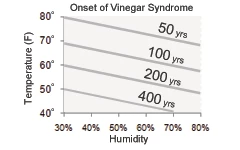
Different combinations of humidity and storage temperature can produce the same preservation effect.
Storage recommendations for movie film
- Avoid projecting it. There are risks from projection--why not have it scanned and share your film that way?
- Consider professional storage. It would be a large project to develop the optimum conditions for preserving your film. If you have a lot of home movie film, it could be more affordable than you think to store your film professionally.
- Keep old movie film cold. The ANSI standard suggests a maximum temperature of 35 degrees F.
- Keep old movie film dry--but not too dry.
Published guidelines from the Image Permanence Institute suggest an ideal range of 20-30% relative humidity. And remember, both temperature and humidity should be constant. - Avoid the attic and the basement.
The attic has too many temperature swings, and the basement is too damp, which can both cause mold and accelerate vinegar syndrome. - Don't use airtight containers.
Kodak published results in the 1990's that showed that airtight canisters tend to accelerate vinegar syndrome. Archival reel cases tend to be vented so that air can pass in and out. If the air in the storage area is not filtered, however, a permeable cardboard enclosure will both allow for air movement and protect the film from dust.
1We have even heard of photographers who shot with movie film.
2In the 1980s, manufacturers introduced many longevity improvements to motion picture film.
Quick Facts
5
Number of years before classic 8mm or Super 8mm film starts to fade, stored in a warm household.
Resources
More About Vinegar Syndrome
Text from a 1996 article in American Cinematographer magazine.read more »
One Hundred Years of Film Sizes
Movie collector Michael Rogge's site documenting the extensive history of movie film.read more »
Measure Your Home's Relative Humidity
Maintaining constant (and low) relative humidity in your storage area is deal. To measure it, you'll need a hygrometer or psychrometer.buy one on amazon.com »
Hollywood Vaults
For the very serious collector, a service that can cryogenically store your precious film and radically slow any further degradation.visit the site »
Quick Facts
41
Ounces of household vinegar a 1,000 ft reel of 35mm movie film could put out in a state of advanced decay.
Acid Detection Strips
A simple tool to check your film collection for the onset of vinegar syndrome. $60.00 for 250 tests.
buy at Image Permanence Institute »

Testimonials
The images I received were amazing quality - just like the original pictures...I loved that ScanCafe had great prices and that I could choose which images to purchase after they had scanned them all - what a deal!
- Connie S.,Toccoa, GA (August 2008)
After moving my mother last year, from the home she had lived in for nearly sixty years, I was left with accumulation from most all those years. Amongst everything was a box of hundreds of slides and photos, some nearly one hundred years old. Thank you ScanCafe for restoring not only the pictures, some of which were pretty damaged, but also for restoring the memories that went with those photos. You've made Christmas extra special for my mother, and all of us, this year
- Joe, North Kingstown RI (Dec 2007)
"I have done a lot of scanning in past years and it has taken me months upon months to achieve the professional results that you gave me in a few weeks. I am so grateful for this timely and cost-effective service."
- J. Adams, Orem UT (Sept 2007)
more testimonials »


